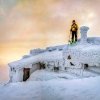Hi all, I'm looking for some advice in regards to mounting an ip (landscape overview) camera in very harsh conditions.
This cabin is located at just above 1800 meters above sea, on a mountain with "a lot of weather". Snow in the winter is by far the worst problem, but winds with gale forces have bent steel tubes up there before as well..
I suspect that a heated dome isn't going to hack it. I have seen them packed with ice as well. The cabin is also closed for extended amounts of time during the winter season - so there are nobody around to clear the cameras.
The mountain from afar. Cabin is located just next to the big antennae at the top.

The cabin seen from the antennae.

Shows light snow conditions, but during the winter, snow will be two meter deep around the cabin.


the cabin seen from it's tallest side during summer

Red dot is where I mounted my hikvision dome for test last week

The same area yesterday after a bit of a blizzard - and the reason why i'm reaching out to get in contact with more experienced operators than myself

A few considerations:
-People can't be identified by these cams (local laws and regulations)
-The location has gigabit fiber Internet, but we initially plan on just using minute stills of a decent quality.
-360 coverage would be cool, but the view straight ahead and to the left in pic gt02 are the primary ones.
Right now I'm evaluating all options for types of cameras. Multiple semi-wide angle raspberry PIs, PTZ dome with preprogrammed stops, fixed mount surveillance cameras.....
If necessary, I could integrate the cameras somewhat into the building by boxing them in, but you see what the frost does to this place in pic gt05 and 06.
Installing an aluminium mast to raise the cameras would be an option... but worried it will be too visible to be strong enough.
Cost is always an issue, but provided I can come up with a workable and great solution - there will be some funding.
I'm very interested in getting in touch with people who's installed and operate cameras in similar locations.
Thanks in advance,
Ørjan
This cabin is located at just above 1800 meters above sea, on a mountain with "a lot of weather". Snow in the winter is by far the worst problem, but winds with gale forces have bent steel tubes up there before as well..
I suspect that a heated dome isn't going to hack it. I have seen them packed with ice as well. The cabin is also closed for extended amounts of time during the winter season - so there are nobody around to clear the cameras.
The mountain from afar. Cabin is located just next to the big antennae at the top.

The cabin seen from the antennae.

Shows light snow conditions, but during the winter, snow will be two meter deep around the cabin.


the cabin seen from it's tallest side during summer

Red dot is where I mounted my hikvision dome for test last week

The same area yesterday after a bit of a blizzard - and the reason why i'm reaching out to get in contact with more experienced operators than myself

A few considerations:
-People can't be identified by these cams (local laws and regulations)
-The location has gigabit fiber Internet, but we initially plan on just using minute stills of a decent quality.
-360 coverage would be cool, but the view straight ahead and to the left in pic gt02 are the primary ones.
Right now I'm evaluating all options for types of cameras. Multiple semi-wide angle raspberry PIs, PTZ dome with preprogrammed stops, fixed mount surveillance cameras.....
If necessary, I could integrate the cameras somewhat into the building by boxing them in, but you see what the frost does to this place in pic gt05 and 06.
Installing an aluminium mast to raise the cameras would be an option... but worried it will be too visible to be strong enough.
Cost is always an issue, but provided I can come up with a workable and great solution - there will be some funding.
I'm very interested in getting in touch with people who's installed and operate cameras in similar locations.
Thanks in advance,
Ørjan

